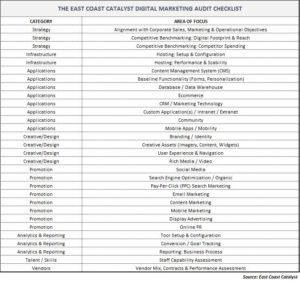Earlier this month, we began this Auditing Digital Marketing article series by addressing the “infrastructure and applications” area of a digital audit. This week, we’ll look at what we call the “promotion” component — which is comprised of any online tactic that’s used to drive website traffic and digital engagement: search, display, social, content, mobile, etc. (The chart below illustrates where promotional activities fit within our audit methodology.)
Promotion is often the largest line item in a digital marketing budget, and comes in the form of both media buys and agency contracts. This kind of activity receives a lot of attention from senior managers because of its growing share of the total advertising budget (online + offline). Accounting for just a few percentage points of all U.S. ad spending in the early 2000s, digital media chewed up 24% of budgets this year, according to new research from Forrester. And that share is expected to increase steadily for the foreseeable future, overtaking television soon.
There are non-media costs to consider as well when discussing digital promotion, of course, such as the talent and technology required to set strategy, manage vendors, and optimize performance. And this can be significant, as digital advertising typically requires more hands-on involvement from marketing groups than TV or print. But since the media component is easier to isolate and benchmark, it makes for a good target during an audit.
When it comes to digital marketing and promotion, most of us continue to rely on channel- and volume-centric strategies, and with good reason. Though imperfect, a strategy organized primarily around specific tactics and making the most of resources allocated to those tactics is manageable: it can be readily measured, communicated up and across the organization, and predicted with an acceptable level of confidence.
Emerging and sophisticated techniques such as attribution modeling or programmatic buying are appealing and should be worked into long term plans, but can be time-consuming and costly to implement in the short term. Most importantly, emerging techniques are, by definition, difficult to forecast. Experimenting in a domain as volatile as digital marketing is a cost of doing business, but should only cost a few percentage points of budget. In our experience, the best way to make due with tight budgets and swelling expectations is to focus efforts on refining proven tactics while carefully choosing which new techniques to work into the mix.
With this background and set of assumptions in mind, we address four hot-button items related to digital promotion in this piece, and offer recommendations for making improvements in 2015.
TAKE A LONG, HARD LOOK AT SEARCH MARKETING
Background: Paid search marketing (PPC) accounts for 40%+ of all digital advertising. Though a relatively mature digital tactic, many companies continue to struggle with optimizing search marketing operations – which include both paid and organic – because of stale management strategies. Given the significant spending that goes into search marketing, even modest improvements can have a big impact on overall digital marketing performance.
In a recent article by McKinsey – “Five Ways to Get More From Digital Advertising” – the authors state: “In our experience, companies may be leaving as much as 20% to 30% of potential [digital advertising] returns on the table.” They cite “uncoordinated external agencies,” as one of the reasons for this under-performance, and go on to say: “the agency handling the paid search budget may be different from the agency advising on organic search-engine optimization (SEO)”.
While it may seem obvious to non-marketers that paid and organic search teams should be collaborating, that hasn’t historically been the case, and this can be easily explained. Paid search advertising relies heavily on media buying skills while organic search marketing involves editorial and technical skills. (Both depend on fundamentally sound user experience strategies to be successful and optimized.) The natural intersection of paid and organic search marketing activities is in keyword strategies, but the day-to-day mechanics don’t necessitate regular cooperation.
However, both disciplines are evolving rapidly and that is changing the rules. Google made 13 updates to its algorithm in 2014 alone, and many experts argue that paid search marketing is quietly overtaking organic’s importance. So while managing an integrated search program is tough, it can yield fast results, if only because of search marketing’s impactful role in “bottom-of-the-funnel” buying behavior, and because it’s an area where companies are already allocating significant dollars, so incremental improvements matter.
Takeaway 1: If you rely on a combination of internal and external resources to manage search marketing, insert a “search marketing director” (or equivalent) to be responsible for overseeing all of the activity. This staffer should be allowed to allocate at least 50% of his or her time to the task if search spend (paid + organic) exceeds $500,000/year. Using the conservative end of McKinsey’s estimates – 20% improvement – this means that even a $1 million search budget (paid + organic) can cost justify this new role (assuming the total annual employee cost is $100,000).
Takeaway 2: If you outsource all search marketing activity to external vendors, reorganize the vendor portfolio to get all search activity to reside at one vendor. If this isn’t possible for whatever reason (e.g., contractual obligations), require all of the vendors to operate in a coordinated manner. Assign coordination duties to one vendor, which will serve as a “general contractor” for all search-related activities (paid, organic, content marketing, analytics).
Expected Challenges: Lobbying for a new full-time position is always time-consuming, as is taking a new approach to vendor management.
RESIST MOBILE AT YOUR OWN PERIL
Background: With phone and tablet internet usage officially overtaking PCs this year, a mobile strategy is a must-have in every digital marketing portfolio.
Mobile had a monster year in 2014, book-ended by Facebook’s acquisition of What’s App for $22 billion in February and Uber’s second fundraising round of $1.2 billion during the year in December. A steady flow of venture investment dollars will fuel its continued rapid expansion. These factors contributed to mobile emerging as a mainstream tactic for marketers.
And while it means marketers have yet another channel/tactic to contend with, it also offers new opportunities. In a recent white paper, the Mobile Marketing Association advised: “Agile marketers who see the opportunity, move first to embrace [mobile], and act analytically and rationally to test, learn, and continually optimize their mobile execution will win. To the winners will come significant financial spoils at the expense of mobile laggards – and all by using same ad spend budgets, but for better results.”
Takeaway: Mobile marketing at even the most aggressive big company will remain a small percentage (1% – 10%) of digital advertising spend. So making dollars available for mobile efforts won’t be a big challenge. But, as a new tactic in the mix, learning curves will be steep, and characterized by iterative test/measure/repeat cycles.
Expected Challenges: Every senior executive — marketing or non-marketing or otherwise — has a high-performance smartphone or tablet these days, so mobile efforts are high profile and ripe for scrutiny.
PREPARE TO ACTIVATE A ‘MULTICHANNEL MARKETING’ INITIATIVE
Background: Multichannel marketing is one of the most frequently discussed topics among digital marketing executives these days. But given its relative newness, you still have time to get out ahead of the pack if you make a move in early 2015.
At the Gilbane Conference this month in Boston, 40% of the 35 breakout sessions had ‘multichannel’ in its title. A friend of mine who heads up a global digital agency told me that 75% of the RFPs he’s reviewed during the second half of this year had ‘multichannel’ in their title. Though a common definition of exactly what multichannel is doesn’t seem to exist, the concept has most definitely arrived.
In broad terms, multichannel digital marketing strategies define an organization’s plans to communicate with constituents across myriad online channels (website, search, social, mobile), as well as how to re-purpose content among those channels. (For example, this article will be posted on LinkedIn in entirety, summarized on our blog, and Tweeted about several times.)
Multichannel strategies can also extend to offline marketing tactics and interactions – such as in-store promotions. The inclusion of offline along with online in the multichannel discussion is sometimes referred to as ‘omnichannel’ marketing. So a company like New Balance or Burger King needs to consider websites, mobile apps, TV advertisements, retail shops, and stores in their multichannel strategies, as well as the unique geographies and demographics they serve. It gets complicated fast, and isn’t easy to execute.
Takeaway: Be prepared to be asked about your multichannel marketing strategy by non-marketing managers, as it’s become that pervasive. If you haven’t already, begin familiarizing yourself with the multichannel landscape by launching a product- or campaign-specific effort, and go from there.
Expected Challenges: Multichannel marketing is near impossible to plan for and execute across an entire marketing organization at a large company or a sizable business unit ($500M+ in sales).
(Note: for a more detailed discussion on multichannel, including a list of do’s and don’t’s to consider, check out Multichannel Content Marketing Is Your Next Challenge: Here’s How to Overcome It at eContent Magazine.)
REVISIT YOUR EMAIL MARKETING STRATEGY
Background: David Carr of the New York Times explained the revival of email newsletters in his recent article, For Email Newsletters, A Death Greatly Exaggerated. He says: “Newsletters are clicking because readers have grown tired of the endless stream of information on the Internet.” We agree.
Email newsletters lack luster. Compared to high-flying digital marketing categories like social media and mobile, email seems like a relic in comparison. But they are quietly on the upswing, and can pay big dividends when done well. To wit: a Gigaom Research study found that U.S. digital marketers named email the most effective tool for awareness, acquisition, conversion and customer retention. Even consumer feelings about email are improving, according to a recent survey by Forrester, especially when communiques are tailored and personalized.
Takeaway: A multifaceted digital marketing operation that is already generating a steady flow of original content can launch or expand email newsletter initiatives without an extraordinary effort. The approach should rely on two broad tactics: 1) As a community-building and nurturing tool aimed at current customers, partners, investors, and even friends and family; and 2) As a more stereotypical direct marketing tactic for acquisition efforts. Assuming that no marketing manager wants to feature an email newsletter as a shiny new concept during this year’s strategy sessions, we recommend a quiet launches of new efforts (or re-launches).
Expected Challenges: The cornerstone of high performing email newsletters are homegrown, opt-in mailing lists, which take time to build. However, many companies have dormant lists that can be revived, but this needs to be pursued carefully, so as not to disrupt other digital marketing efforts, such as organic search.
Tim Bourgeois is a digital strategist and partner at East Coast Catalyst, a Boston-based firm that help companies employ digital strategies for growth and competitive advantage. Contact him at tbourgeois(at)eastcoastcatalyst.com or 617-314-6400.
FURTHER READING
Digital Marketing Audit: The ECC Methodology & Approach
Ad Fraud Detection Techniques & Strategies for Marketers
Programmatic Advertising Trends: Dealing With Fraud & Negative Experiences
Online advertising fraud & CMO strategies
Digital Marketing Best Practices

